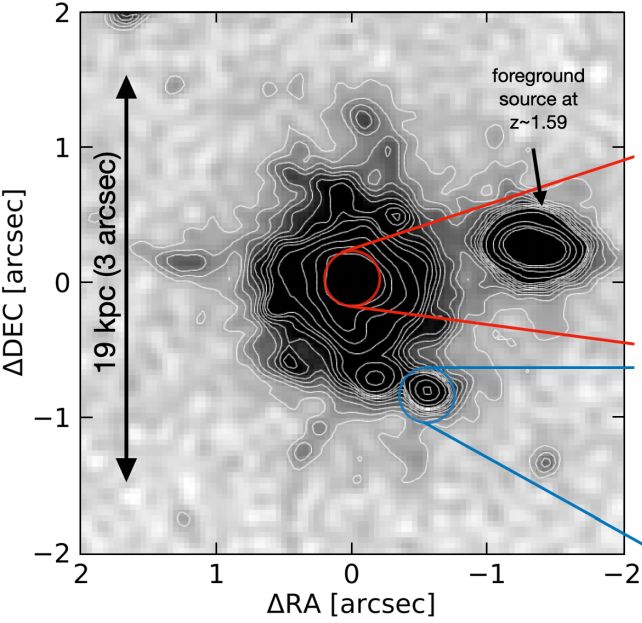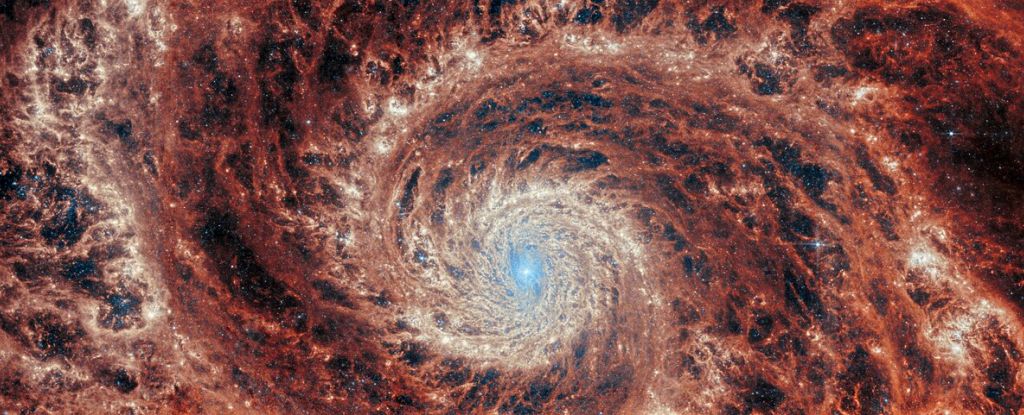Back when the Universe was new, following the Big Bang some 13.8 billion years ago, galaxies took a bit of time to assemble themselves from the surrounding primordial soup.
A new discovery right at the end of the Cosmic Dawn is challenging how long we thought that assembly took. JWST has spotted a huge, ultramassive galaxy as it appeared 12.8 billion years ago, so intricately structured that it can only belong to the most spectacular category of galaxies: the grand design spiral.
The galaxy’s name is Zhúlóng, after the Torch Dragon of Chinese myth, and its discovery has been detailed in a paper uploaded to preprint server arXiv ahead of peer review and publication.
“Zhúlóng shows that mature galaxies emerged much earlier than expected in the first billion years after the Big Bang,” writes a team led by astronomer Mengyuan Xiao of the University of Geneva in Switzerland.
“Our finding offers key constraints for models of massive galaxy formation and the origin of spiral structures in the early universe.”
In the Universe around us today, galaxies come in a number of different shapes and sizes. Lenticular galaxies are sort of blobby and formless, while spiral galaxies have defined spiral arms curving out from their centers.
The grand design spiral galaxy is the most magnificently structured sort of galaxy, with prominent, well-formed and visible spiral arms curving away from a bright, well-defined galactic center; almost the platonic ideal of what a spiral galaxy should look like.
We don’t have a clear idea about when spiral galaxies first started to come together in the Universe, but they’re pretty rare the further back in space-time we peer, and practically absent more than about 11.5 billion years ago.
Zhúlóng was discovered serendipitously in data collected by JWST for its PANORAMIC survey, an observation campaign to observe galaxies in the Cosmic Dawn, the first billion years after the Big Bang.
Although the survey has spotted other massive galaxies, Zhúlóng, the team says, is truly incredible.
“It has a striking evolved morphology: a quiescent-like classical bulge + star-forming stellar disk + grand-design spiral arms (defined as spiral structures spanning the whole galaxy, from the nucleus to outskirts, with spiral arms starting at diametrically opposite points), already at 1 billion years after the Big Bang,” they write in their paper.

In addition, it’s quite large for a galaxy in the early Universe, measuring some 62,000 light-years in diameter, with a mass comparable to that of the Milky Way. The black hole in its center seems to be quiescent, suggesting that the star formation rate of between 20 and 155 solar masses per year is slowing.
All together, the data indicate a galaxy that has gone through the throes of formation and is settling down into a sedate, well-defined structure.
The researchers believe that Zhúlóng represents the earliest example of a spiral galaxy seen to date. This suggests that a Milky Way-like galaxy can form far faster than we thought – around 10 times faster than such formation would take place in the local Universe.
“The presence of all of these properties makes Zhúlóng very exceptional,” the researchers write, “indicating the rapid formation and morphological evolution of massive galaxies in the early Universe.”
The team’s paper has been submitted to Astronomy & Astrophysics and is available on arXiv.





